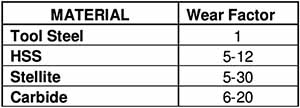

Toughness is the property that enables a material to absorb energy before breaking. It is the total resistance to failure in both the elastic and plastic zone. Toughness is often referred to as impact strength. This property is especially important for tools that will encounter impurities (like metal staples) or when machining materials that are inconsistent. Inconsistent materials will cause a “shock” to the tool as it enters and exists the variable densities. A tool that is not tough enough will break due to this “shock”. (9)
Oftentimes the tool shank and body will be made from tool steel, while the cutting edge is carbide. This is because tool steel is a much tougher material than carbide. This allows the tool body to withstand sudden changes in forces without breaking. While the carbide is less tough, it is much harder and able to hold a sharp edge longer, making it ideal for the cutting edge. (9)
Hardness determines a material’s ability to resist surface penetration. Although it is not the only factor, generally speaking, the greater a material’s hardness the better its wear resistance. This equates to a longer tool life. However, a material that is harder is also more brittle, meaning it is more fragile and more prone to chipping or breaking from impact loads. (9)

The wear resistance of a material is very important, as it will influence how often the tools will have to be sharpened. Under ideal conditions, materials with high wear resistance need to be changed less often. But they are also more expensive. A balance must be found between the cost of the tool and the cost of maintenance. (9)
A load cycle is when a tool undergoes intermittent and/or varying stress levels. This repeated on/off pattern causes fatigue stresses. A material’s endurance is its ability to withstand repeated load cycles. This is an important property to be aware of as it is the cause of many tool failures. If fatigue stresses exceed a material’s rating, small cracks form that can propagate and result in tool failure. (9)